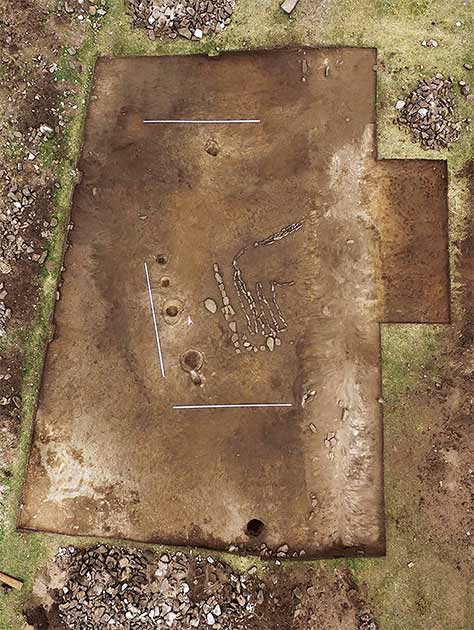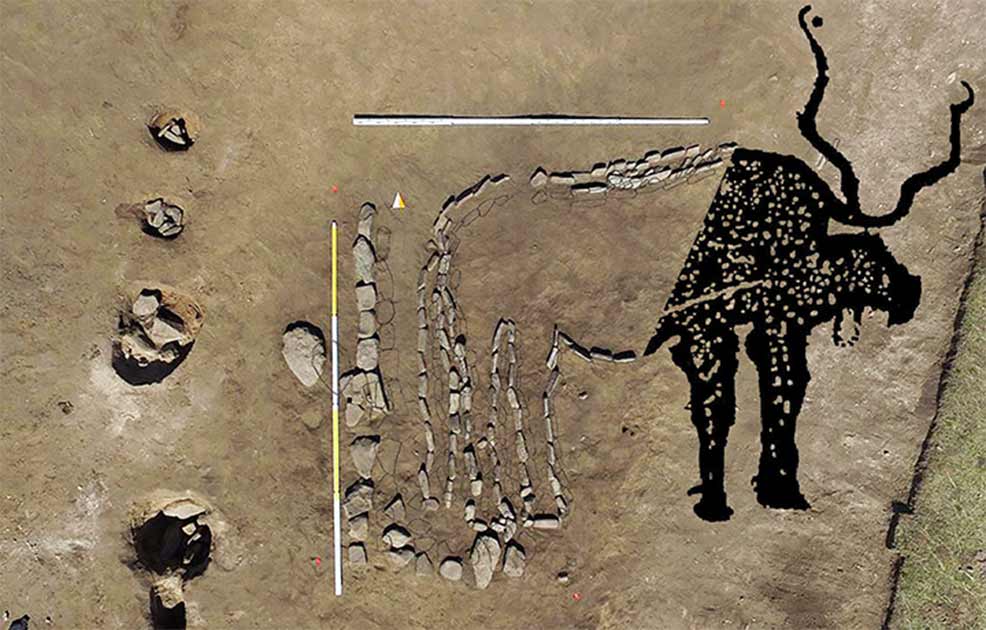Bronze Age Bull Geoglyph Found In Siberia Is A First
Archaeologists conducting excavations at the Jonderguéi 22 site in the south-west of the Republic of Tuva in southern Siberia have made the exciting discovery of a bull geoglyph. It is believed to be the first animal geoglyph find in the entire Central Asia region. The excavations near Khondergey village, close to Russia’s border with Mongolia, were conducted by a team of archaeologists from the Institute of History of Material Culture of the Russian Academy of Sciences (IIMK RAS) and LLC Krasnoyarsk Geoarchaeology.
The 3-by-4-meter (10-by-13-foot) bull geoglyph was found in a large Early Bronze Age burial site. Ceramics dating as far back as 4000 years ago have also been unearthed at the site, which means the Siberian bull geoglyph is twice as old as the Nazca Lines in Peru and predates the UK’s Uffington Horse geoglyph by a thousand years.

This enormous monkey geoglyph is one of the most famous geoglyphs in the extensively researched Nazca site in the Peruvian desert. However, the recently discovered Siberian Tuva bull geoglyph is more than 1,000 years older than the ancient animal line art at the Nazca site. (Daniel Prudek / Adobe Stock)
From Peru’s Nazca Lines to the Siberian Bull Geoglyph
Geoglyphs are large motifs, usually larger than 4 metres (13 feet), created on the ground by an arrangement of pebbles, stones, gravel and other durable materials. They can be either positive, that is made by an arrangement of the materials on the ground, or negative, that is made by carving out part of the ground. They differ from petroglyphs in that the latter are rock art made by carving or chipping out designs on rock surfaces. Geoglyphs are much larger designs created in such a way that they stand out from the surface of the earth.
The most famous geoglyphs are perhaps the Nazca Lines of Peru which, according to Encyclopaedia Britannica, are “groups of geoglyphs, large line drawings that appear, from a distance, to be etched into the Earth’s surface on the arid Pampa Colorada…, northwest of the city of Nazca in southern Peru. They extend over an area of nearly 190 square miles (500 square km).” While most of the Nazca Lines are around 2000 years old, some date back to an even earlier “mystery” culture.
- Ten Amazing and Mysterious Geoglyphs from the Ancient World
- Ancient Geoglyphs of Kazakhstan: The Mysterious Markings in Danger of Destruction
The United Kingdom’s famous Uffington Horse or Uffington White Horse is a relic from the Iron Age carved into the white chalk hillside of the Berkshire Downs. It is one of a series of human and equine geoglyph figures cut into the chalk hills of southern England.
Earlier this year, a group of eight geoglyphs that are believed to be the largest in the world were found in the Thar Desert in India. These incredible geoglyphs are so big that their creators likely never saw the entirety of their work.
The geoglyph of the bull found in Siberia recently stands out not for its size but for its age (2000 BC) and its location. No other animal geoglyph has been found in Central Asia so far except this one!

The stone bull geoglyph was part of this Early Bronze Era burial from over 4,000 years ago, discovered in southern Siberia near the Mongolian border. (Institute of History of Material Culture / Siberian Times)
What’s So Special about the Siberian Bull Geoglyph?
Marina Kilunovskaya, who leads the Tuvan archaeological expedition, told The Siberian Times, “The bull motif is very typical for the Central Asia cultures of the Early Bronze Era. Later in Scythian times bulls were replaced by deer. We do see bulls as petroglyphs around Tuva and the neighbouring territories - but coming across the animal geoglyph is a unique discovery for the whole region of Central Asia. We didn’t previously find such stone compositions.”
The geoglyph is constructed of pebbles and pieces of local sandstone arranged together to resemble a bull. However, in the 1940s road construction work unfortunately completely destroyed its head and torso and only its hindquarters and tail remain. According to Market Research Telecast, Natalia Lázarevskaya, a member of the Tuva excavation team said that only the haunches of the find remain preserved while the rest was dismantled by road work.
Members of the archaeology team hope that the uniqueness of the find coupled with the damage it has suffered in modern times will induce authorities to ensure its preservation as part of a protected site. Heritage Daily has quoted Marina Kilunovskaya as saying, “Although we can recognise the bull depiction, allowing us to reconstruct the lost parts with a high degree of probability, we have never seen stone layouts such as these before. In our opinion, the uniqueness of the find and the threat to the site due to the adjacent road requires further preservation.”
Hopefully, further examination of the fascinating Siberian bull geoglyph and the area where it was discovered will throw more light on its origins including who made it and why.
Top image: The Siberian stone bull geoglyph, which measured 3 by 4 meters (10 by 13 feet), was part of an Early Bronze Era burial from more than 4,000 years ago, making it one thousand years older than the Nazca Lines in Peru. The Siberian geoglyph is the first animal geoglyphs discovered in the Central Asian region. Source: The Siberian Times
By Sahir Pandey
References
Institute for the History of Material Culture of the Russian Academy of Sciences. 2021. Bull geoglyph discovered in Southern Siberia. Available at: https://www.heritagedaily.com/2021/09/bull-geoglyph-discovered-in-southern-siberia/141527?fr=operanews.
Liesowska, A. and Skarbo, S. 2021. Bull geoglyph twice as old as Nazca Lines (Peru), predating Uffington Horse (UK) found in Siberia. Available at: https://siberiantimes.com/other/others/news/bull-geoglyph-twice-as-old-as-nazca-lines-chile-and-predating-uffington-horse-uk-discovered-in-siberia/.
Market Research Telecast. 2021. Photos: They find in Siberia a unique geoglyph in the shape of a bull twice as old as those of Nazca. Available at: https://marketresearchtelecast.com/photos-they-find-in-siberia-a-unique-geoglyph-in-the-shape-of-a-bull-twice-as-old-as-those-of-nazca/164612/.
Pandey, S. 2021. World’s Largest Geoglyphs Found in India’s Thar Desert. Available At: https://www.ancient-origins.net/news-history-archaeology/thar-desert-geoglyphs-0015375.



















